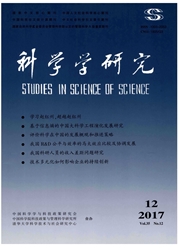

 中文摘要:
中文摘要:
利用101个国家和地区18076个非金融企业2005~2014年的面板数据,主要将中国与美国、英国、日本、德国、印度6个国家企业的研发投入规模与强度的结构特征进行分析得到:第一,发达国家的跨国公司主导全球研发,中国顶级企业研发投资规模与之相比差距较大,经济增长缺乏引领全世界技术创新的核心企业的支撑,且依靠能源、原材料消耗和固定资产投资推动;第二,与发达国家企业研发投入的行业分布特征比较发现:中国能源行业企业的研发投入规模与发达国家企业相比差距较小,反映了国家对绿色经济增长模式的重视;中国信息科技行业企业的研发强度在本国所有行业的企业中较高,但企业研发投入规模过小,可能在一定程度上影响中国产业链的延伸;中国企业在医疗保健、消费者非必需消费品行业的研发投入规模和强度与发达国家差异较大,主要受人均收入水平决定的经济复杂度制约,这将影响中国产品品质与质量的升级;第三,与发达国家企业研发投入的年龄分布特征和规模分布特征比较发现,中国高龄企业、小型企业研发投资规模过低,新创企业、大型企业研发投资强度高。
 英文摘要:
英文摘要:
Using panel data of 18076 non-financial firms from 101 countries and regions during the period 2005 ~ 2014,we analyze the differences and characteristics of RD investment scale and intensity of China,the United States,Britain,Japan,Germany and India and conclude that: First,RD investment scale of China's top firms is too little compared to developed countries' multinational firms which lead global RD activities. China's economic growth can't be supported by core firms powerfully which lead the world's technological innovation,and it is driven by consumption of energy and materials and investment in fixed assets. Second,the gap of firms' RD investment scale between China's energy industry and that of developed countries is relatively small,which reflects China's attention to the green economic growth model. The RD intensity of information technology industry in China is relatively high compared to firms of other industries,but the RD investment scale is still small,which may affects the extension of China's industrial chain to a certain extent. The gap of RD scale and intensity of healthcare and consumer discretionary industry between China and developed countries is relatively deep,which is mainly confined by economic complexity that per capita income determines. Third,the differences of firms' RD investment between China and major countries also vary from firm age and size. Old and small firms invest less in RD,start-ups and large firms have high-intensity RD investment.
 同期刊论文项目
同期刊论文项目
 同项目期刊论文
同项目期刊论文
 期刊信息
期刊信息
